
Say “P-bass on steroids” again! Say “P-bass on steroids” again! I dare you! I double dare you, motherf*cker! Say “P-bass on steroids” one more g*dd*mn time!
-Jules Winnfield, “Pulp Fiction” (1994)
Almost any discussion of the 3000 and 3001 basses brings up that tired old cliche, but we’re not going to do that here. I promise! So with that off the table, what else is there to say about these 1970s era bolt-on boat anchors?
Let’s start with something I bet you don’t know: they first appeared on the price list way back in 1971. “1971, you say? I thought the 3000 and 3001 didn’t come out until the mid 1970s?” You are correct. They didn’t. These aren’t the 3000 and 3001 you’re thinking of. And they don’t actually exist.

Well, at least one of them is hanging in the factory museum, but as a production guitar? Vaporware. Indeed, that 1971 price list included four Forrest White designed guitars, none of which made it into production.
“Wait, Forrest White? As in Fender plant manager Forrest White?” One and the same. It seems that after a couple of years under the new regime he and CBS weren’t getting along so well, and so they parted ways in 1967. Eventually he landed at Rickenbacker—which was in pretty dire straits at the time and was looking for new ideas. Who better than Leo Fender’s former right hand man?
One of Forrest’s ideas was a decidedly “double cutaway Telecaster”-ish design. Put a bolt on neck on it and some new pickups and bingo you’ve got a budget-friendly Rickenbacker that wasn’t a Rickenbacker and could compete with…Fender. The design yielded both two guitars (the 430 and 470 prototypes) and a short-scale (30”) bass with deluxe (3000) and standard (3001) iterations, all of which got shown at NAMM and added to the 1971 price list. But none actually got built. Why? Dunno.
But F.C. (and John!) must have liked the design, even if it wasn’t quite what they wanted right then. It would go on to reappear on the 490 prototype in 1973, the 430 (a different one than the 1971 prototype) in 1974, and the 200-series guitars in 1984. And of course on the 3000 bass (again!) in 1975.
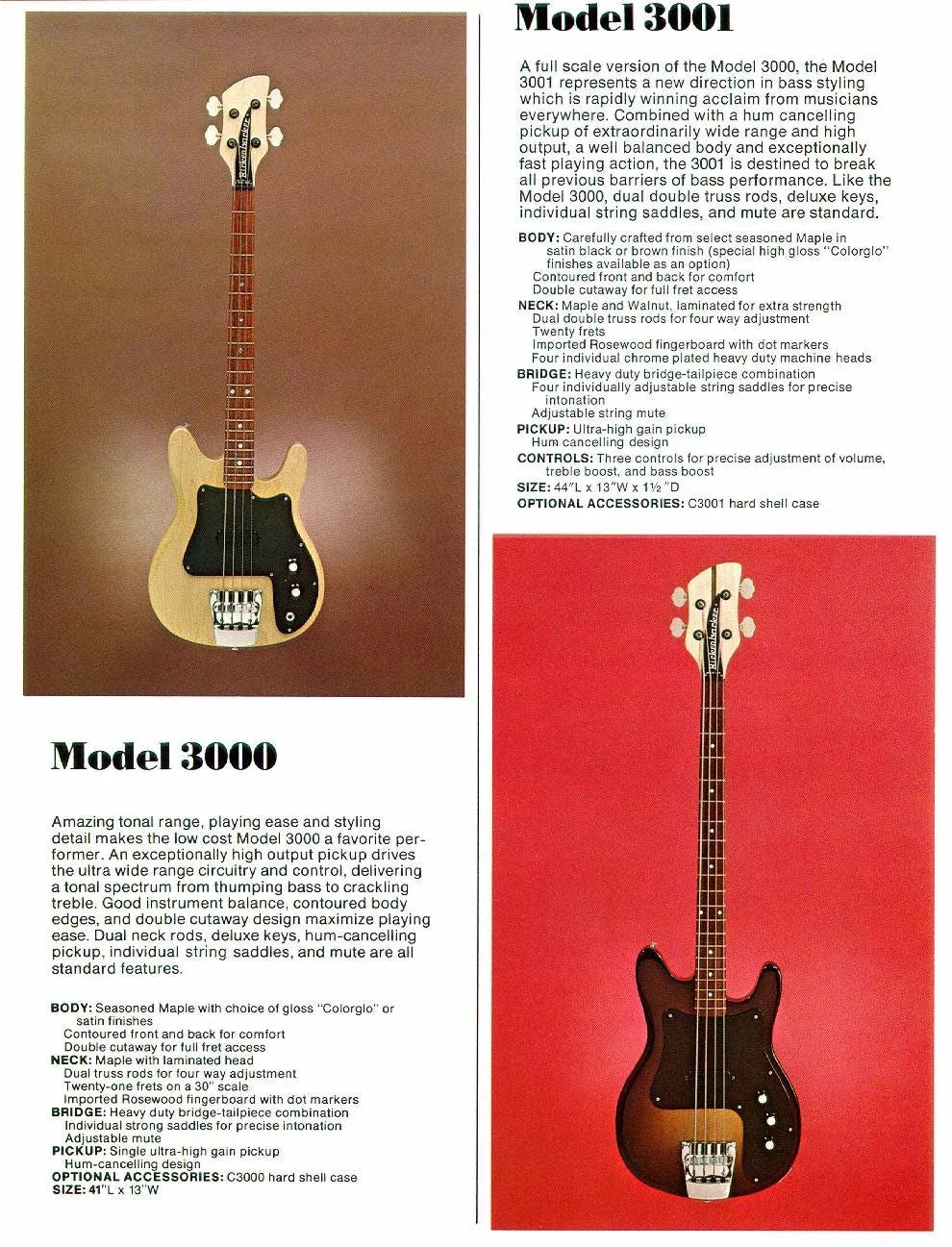
So let’s jump forward to 1975. And just to clear things up, while the stillborn 1971 3000 and 3001 were both short-scale, when the production models arrived in 1975 only the 3000 was short-scale—the 3001 was normal 33.25” scale with the 1971 body stretched proportionately.
Some features were shared between the two, some were unique. Both had solid center-seamed two piece maple bodies, bolt-on unbound maple necks with dot inlays and a paddle headstock—a first for Rickenbacker basses!—standard 4-saddle adjustable bridge with integrated mute, Kluson tuners, and a brand new pickup.
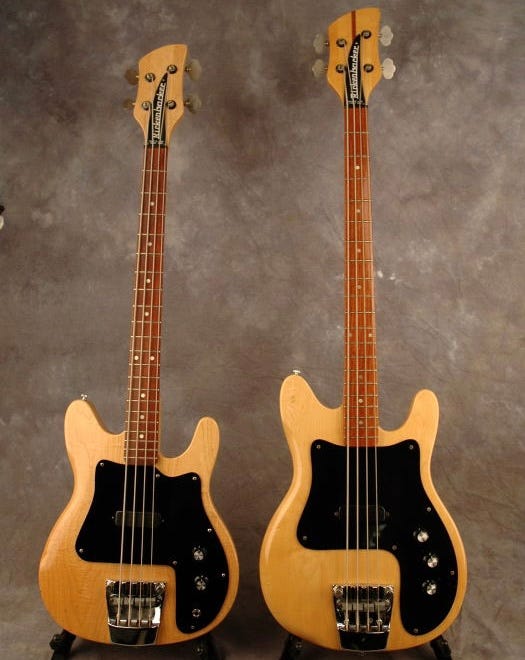
One of the first differences you’ll note (apart from the size) are the necks. The 3000 had a one piece maple neck with maple wings and 21 frets. The 3001’s neck, however, was a three piece maple/shedua skunk stripe/maple sandwich with maple wings and 20 frets—identical to the 4000/4001 because the same neck blanks were used on the bolt-on 3001 and set neck 4000/4001S. The headstock was also slightly wider on the 3001.

Here’s one of those weird little details you don’t really notice until you do: on the 3000’s smaller headstock a stock truss rod cover doesn’t quite fit between the tuner bushings—it’s a little too wide to fit between the E and G tuner and a little too long to avoid the D tuner—so they had to manually reshape them/slim them down a little bit to make them fit.

Although they shared the same pickup, the wiring was different between the two models. The 3000 featured single volume and tone knobs, and a face mounted output jack.

The 3001 had 3 knob layout that is often misdescribed as volume, bass boost, and treble boost. Boost implies active electronics, which the 3001 does not have. They should be more accurately described as volume, treble cut (aka a normal tone control) and bass cut. The best description I can find of how it actually works is that the bass cut control doesn’t do much on its own but has a dynamic effect on the treble cut knob—kinda in the same way the treble and bass knobs interact on a Vox AC30. The output jack was side mounted.
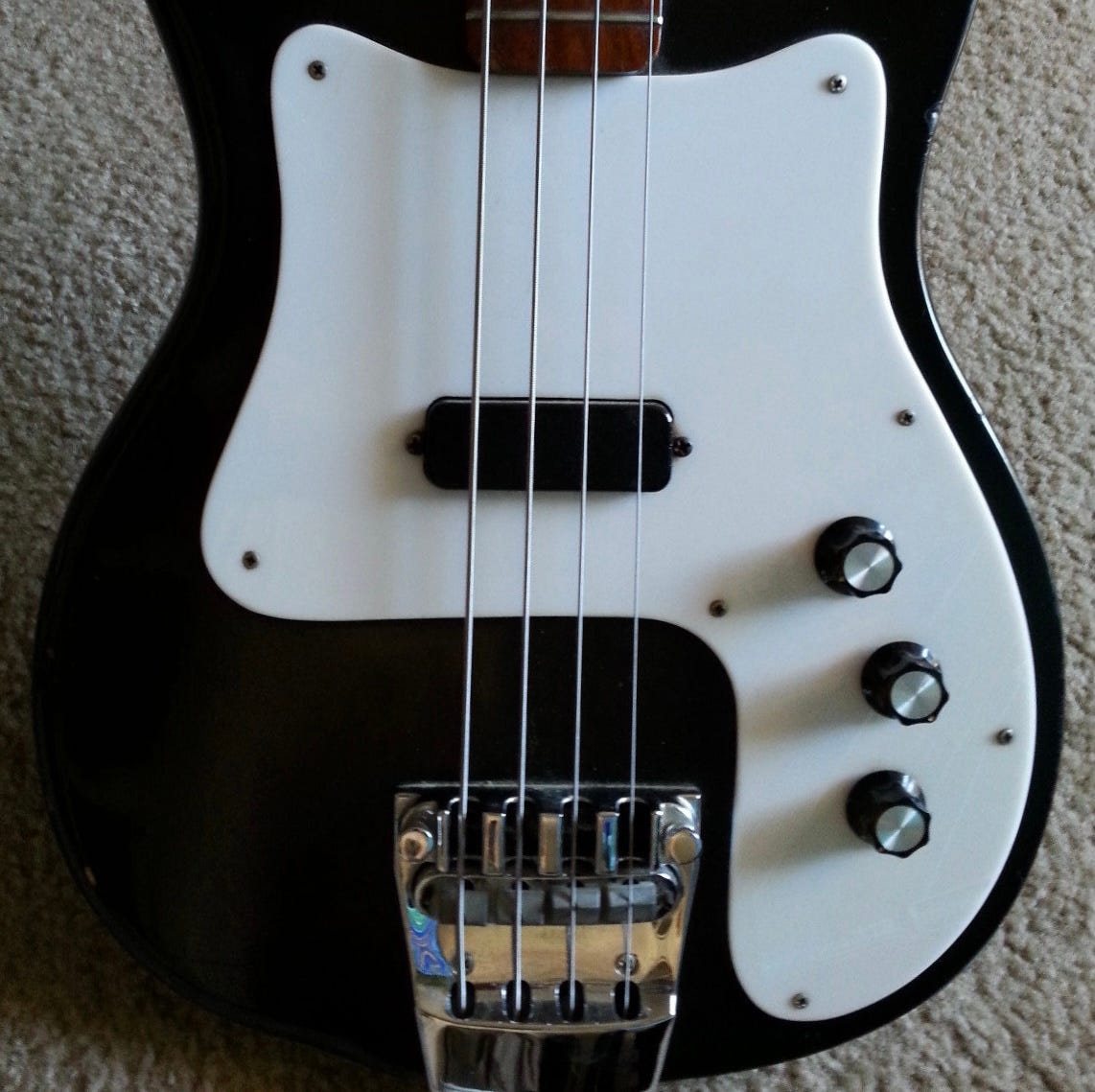
The 3001’s pickguard vaguely echoed the 4001’s to provide a little “brand identity continuity”. The 3000’s? I mean, it kinda looks like the 3001’s pickguard had a stroke…
Now about that “super high gain hum-cancelling” pickup. It is NOT a humbucker. It is a shielded single coil encased in epoxy with an output of about 8.5 ohm. Because of the expoxy, if it dies…it’s dead. No repair or rewinding is possible. Fun fact: the same pickup would be used for the first few years of the 200/2000 series guitars in a different case.
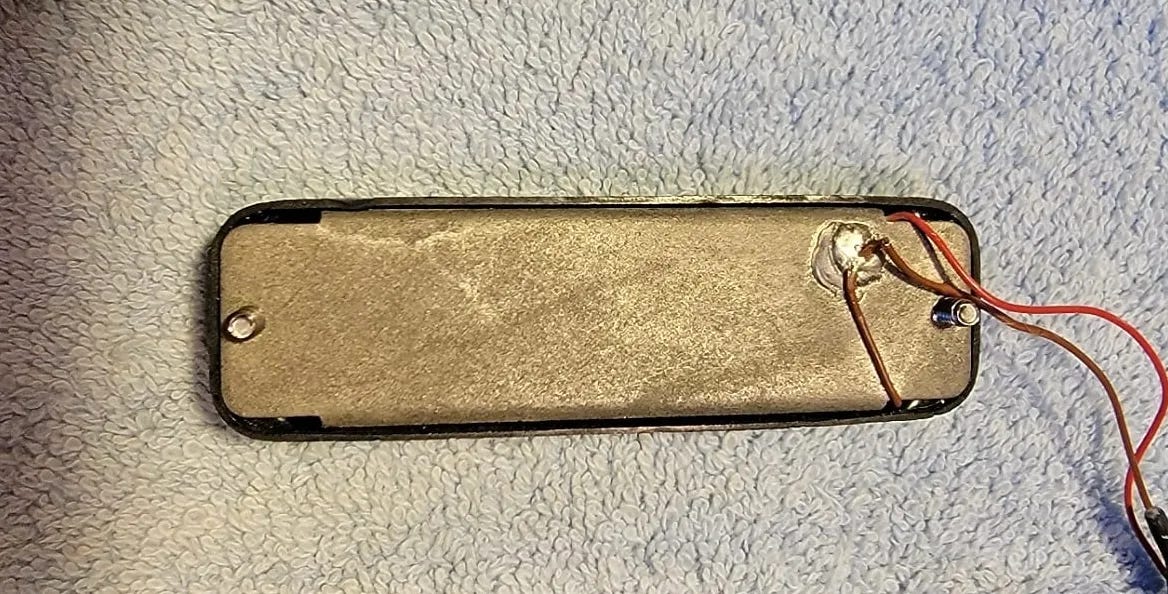
So what does it sound like? Well, most folks say it sounds like a P…nope, nope, nope. Not gonna say it. But you know, right? That said, the tone shaping capabilities on the 3001 in particular makes it pretty versatile, but the one sound you CAN’T dial in on either model is the Rickenbacker “growl”.
Oh! Here’s another subtle difference I need to point out. In addition to the bodies being different, the contouring is different as well. While neither has a Fender-style “comfort carve” on the back, the 3001 is more contoured than the 3000. Look…let me just show you:

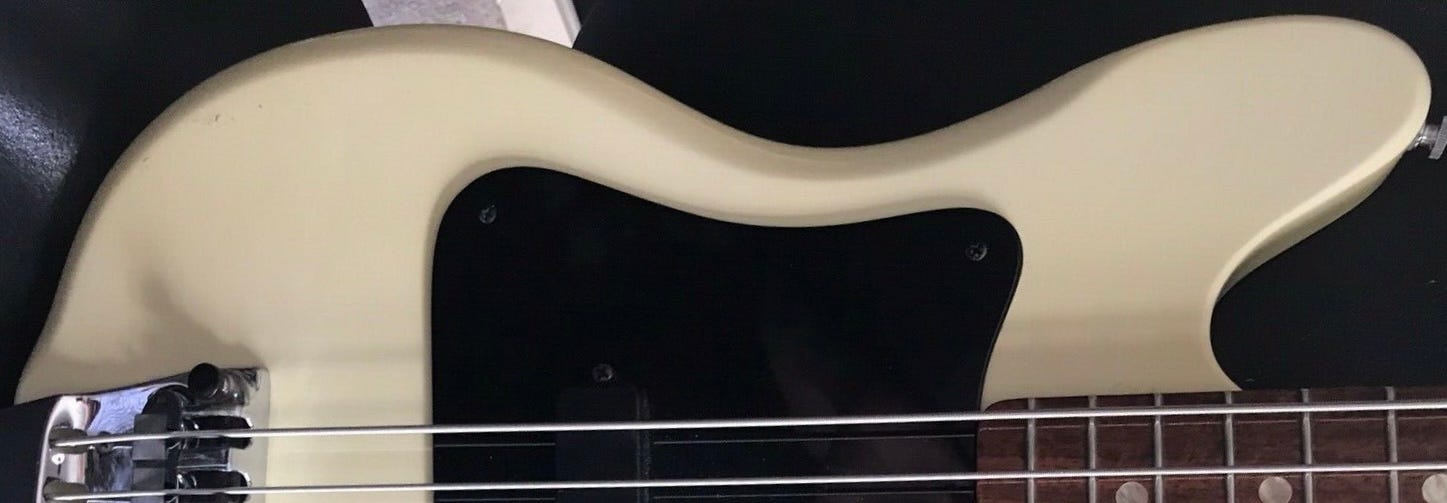
The 3000, on the top, has what I’d call “normal solidbody Rickenbacker contouring” like you find on the 450, 610, 4001S, etc.: contoured on the upper side from just above the waist to about halfway down the lower bout. All other edges are rounded over just enough to keep them from being sharp. The back has similar contouring on both sides.
The contouring on the top side of the 3001, however, runs all the way around the lower bout to the bridge. Additionally, the cutaway edges are more rounded over—not P-bass rounded over, but also not “almost slab” like the 3000. On the back, the top side contouring mirrors the top’s pattern with the bottom side being more “standard Rickenbacker”.
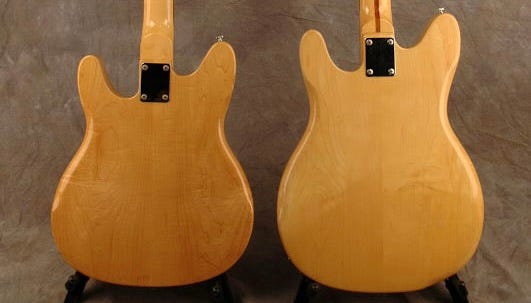
While never officially called out on the price list, it seems the 3001 could be custom ordered in fretless as a number exist. The same does not appear to be true for the short scale 3000. Unlike the 4001FL, the fretless 3001 did not get the fancy larger pearl dot inlays.

Apart from the phrase I shall not mention, the other thing people always say about the 3000 and especially the 3001 is that they are HEAVY. Fact check: true. Many 3001s weigh in at 11 plus pounds—with weights up to 13 pounds having been reported.
As far as changes over their production run, the only one of note was the truss rod cover which followed the rest of the line in moving from backpainted plexiglass to raised letter injection molded in early 1976. Both models had their model number stamped on the molded truss cover, which came in both black and white.


Both models would remain on the price list until 1984. In reality, almost all 3000s were made in 1975 and 1976, with only a handful made between 1977 and 1979 and none after that. 3001 production ran from 1975-1979, peaking in 1976 and declining from there.
So that’s the “what” of the 3000 and 3001. How about the “why?” Well, even though 4001 production exploded in 1973, turning Rickenbacker’s fortunes around, they were expensive. If Rickenbacker basses were popular—which they were—maybe a lower cost guitar could compete directly with Fender and capture a different piece of the market. That was the theory, anyway.
It didn’t…to the extent they had maybe hoped it would. I mean, it wasn’t a flop, but neither was it a smash hit. Was it market indifference—or was it still-growing 4001 demand consuming all available factory capacity? Probably a bit of both, but I’d expect it was more of the latter than the former. Look, sales of the 3000 were still pretty strong when it was effectively discontinued at the end of 1976. You don’t kill a product that’s doing okay unless you can make more money doing something else.
It’s a story as old as time: used guitars without a famous artist association and weren’t hugely popular sell for cheap and become cheap used guitars. Cheap used guitars get abused and modified because who cares? It’s a cheap used guitar. Nice 3000s and 3001s exist today, but they’re getting harder to find. And without a famous artist association or a huge fan base, they still sell for relatively cheap. People who love ‘em, love ‘em. But it’s a…selective audience. Is it worth a try? Sure! As long as it’s cheap and you aren’t expecting it to sound like a Rickenbacker…
Want to learn more about…everything? Check out the rickenbacker101 site map and see what’s already been covered! Have a suggestion about what we should tackle next? Drop it in the comments and we’ll add it to the queue!




Well done, Andy!
"Unlike the 4001FL, the fretless 3001 did not get the fancy larger pearl dot inlays.", but the 3000 fretted did get the fancy larger pearl dot inlays...